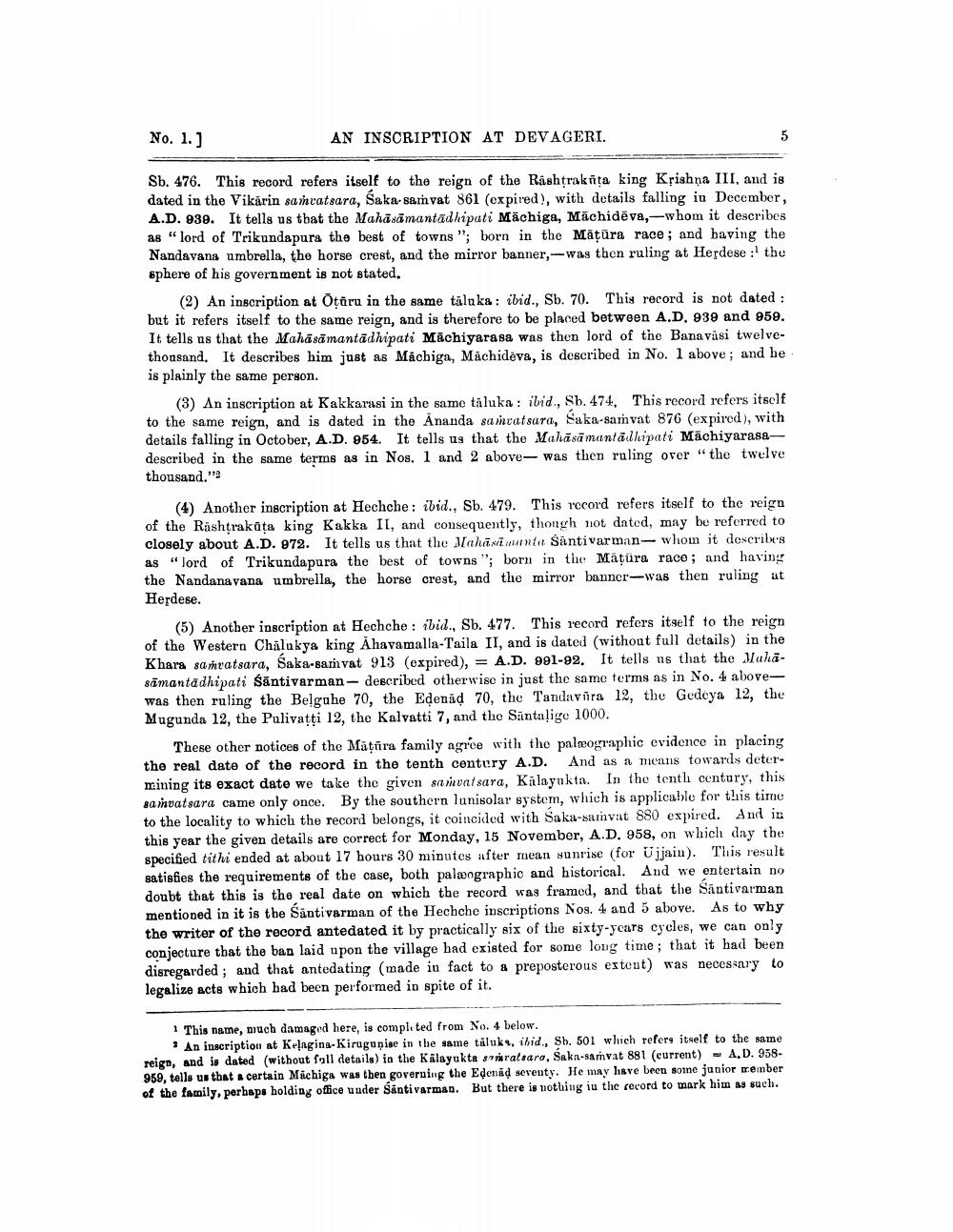________________
No. 1. )
AN INSCRIPTION AT DEVAGERI.
Sb. 476. This record refers itself to the reign of the Rashtrakūta king Krishna III, and is dated in the Vikärin samvatsara, Saka-samvat 861 (expired), with details falling in December, A.D. 939. It tells us that the Mahāsāmantadhipati Mächiga, Māchidēva,-whom it describes as “lord of Trikundapura the best of towns"; born in the Mäțura race; and having the Nandavans umbrella, the horse crest, and the mirror banner,-was then ruling at Herdese : thu sphere of his government is not stated.
(2) An inscription at Otūru in the same täluka: ibid., Sb. 70. This record is not dated : but it refers itself to the same reign, and is therefore to be placed between A.D. 939 and 959. It tells us that the Mahāsāmantādhipati Michiyarasa was then lord of the Banavusi twelvethousand. It describes him just as Machiga, Máchideva, is described in No. 1 above; and he is plainly the same person.
(3) An inscription at Kakkarasi in the same täluka: ibid., Sb. 474. This record refers itself to the same reign, and is dated in the Ananda sa vatsara, Saka-samvat 876 (expired), with details falling in October, A.D. 954. It tells us that the Mahāsa mantadhipati Māchiyarasadescribed in the same terms as in Nos. 1 and 2 above-- was then ruling over "the twelve thousand."
(4) Another inscription at Hechche: ibid., Sb. 479. This record refers itself to the reign of the Rashtrakata king Kakka II, and consequently, thongh not dated, may be referred to closely about A.D. 972. It tells us that the Mahāximinta Santivarman- whom it describes as “lord of Trikundapura the best of towns"; born in the Mäțura race; and having the Nandanavana umbrella, the horse crest, and the mirror banner-was then ruling at Herdese.
(5) Another inscription at Hechche : ibid., Sb. 477. This record refers itself to the reign of the Western Chalukya king Ahavamalla-Taila II, and is dated (without full details) in the Khara samvatsara, Saka-samvat 913 (expired), = A.D. 991-92. It tells us that the Mahasāmantadhipati sāntivarman - described otherwise in just the same terms as in No. 4 abovewas then ruling the Belguhe 70, the Edenad 70, the Tandavörn 12, the Godoya 12, the Mugunda 12, the Pulivatti 12, the Kalvatti 7, and the Süntalige 1000.
These other notices of the Māțara family agree with the palæographic evidence in placing the real date of the record in the tenth century A.D. And as a means towards determining its exact date we take the given samvatsara, Kalayukta. In the tenth century, this samvatsara came only once. By the southern lunisolar system, which is applicable for this time to the locality to which the record belongs, it coincided with Saka-sainvat 880 expired. And in this year the given details are correct for Monday, 15 November, A.D. 958, on which day the specified tithi ended at about 17 hours 30 minutes after mean sunrise (for Ujjain). This result satisfies the requirements of the case, both palæographic and historical. And we entertain no doubt that this is the real date on which the record was framed, and that the Santivarman mentioned in it is the Säntivarman of the Hechche inscriptions Nog 4 and 5 above. As to why the writer of the record antedated it by practically six of the sixty-years cycles, we can only conjecture that the ban laid upon the village bad existed for some long time; that it had been disregarded ; and that antedating (made in fact to a preposterous extent) was necessary to legalize acts which had been performed in spite of it.
1 This name, nuch damaged here, is completed from No. 4 below.
1 An inscription at Kelagina-Kiruguņise in the same taluks, ibid., Sh. 501 which refers itself to the same reign, and is dated (without foll details) in the Kalayukta soratrara, Saka-sarvat 881 (current) - A.D. 958959, tells us that a certain Machiga was then governing the Edenad seveuty. He may have been soie junior member of the family, perhaps holding office under Säntivarman. But there is nothing in the record to mark him as such.




